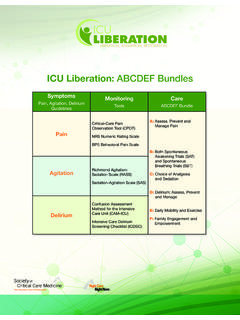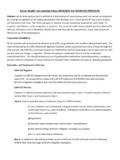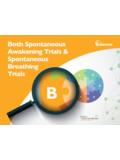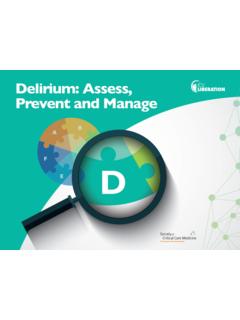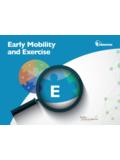Transcription of Pain, Agitation, and Delirium Pocket Card x Assess
1 pain , agitation , and Delirium x Pocket card agitation in critically ill patients may result from inadequately treated pain , anxiety, Delirium , and/or ventilator dysynchrony. Detection and treatment of pain , agitation , and Delirium should be reassessed often in these patients. Patients should be awake and able to purposely follow commands in order to participate in their care unless a clinical indication for deeper sedation exists. For a comprehensive list of Guideline Statements, Recommendations and GRADES, see back of card . Assess and Treat Statements and Recommendations pain assessment should be routinely performed in all ICU patients (1B). Self report is preferred over the use of behavioral pain scales to Assess pain in ICU patients who are able to communicate (B). The BPS and CPOT are the most valid and reliable behavioral pain scales for use in ICU patients who cannot communicate (B). Vital signs should not be used alone to Assess pain , but they may be used adjunctively for pain assessments (2C).
2 pain . Preemptively treat chest tube removal with either analgesics and/or non-pharmacologic therapy (1C). Suggest preemptively treating other types of procedural pain with analgesic and/or non-pharmacologic therapy (2C). Use opioids as first line therapy for treatment of non neuropathic pain (1C). Suggest using non-opioid analgesics in conjunction with opioids to reduce opioid requirements and opioid-related side effects (2C). Use gabapentin or carbamazepine, in addition to intravenous opioids, for treatment of neuropathic pain (1A). Use thoracic epidural for postoperative analgesia in abdominal aortic surgery patients (1B). Suggest thoracic epidural analgesia be used for patients with traumatic rib fractures (2B). Depth and quality of sedation should be routinely assessed in all ICU patients (1B). The RASS and SAS are the most valid and reliable scales for assessing quality and depth of sedation in ICU patients (B). Suggest using objective measures of brain function to adjunctively monitor sedation in patients receiving agitation neuromuscular blocking agents (2B).
3 Use EEG monitoring either to monitor non-convulsive seizure activity in ICU patients at risk for seizures, or to titrate electrosuppressive medication to achieve burst suppression in ICU patients with elevated intracranial pressure (1A). Target the lightest possible level of sedation and/or use daily sedative interruption (1B). Use sedation protocols and checklists to facilitate ICU sedation management (1B). Suggest using analgesia first sedation for intubated and mechanically ventilated ICU patients (2B). Suggest using non-benzodiazepines for sedation (either propofol or dexmedetomidine) rather than benzodiazepines (either midazolam or lorazepam) in mechanically ventilated adult ICU patients (2B). Delirium assessment should be routinely performed in all ICU patients (1B). The CAM ICU and ICDSC Delirium monitoring tools are the most valid and reliable scales to Assess Delirium in ICU patients (A). Delirium Mobilize ICU patients early when feasible to reduce the incidence and duration of Delirium , and to improve functional outcomes (1B).
4 Promote sleep in ICU patients by controlling light and noise, clustering patient care activities, and decreasing stimuli at night (1C). Avoid using rivastigmine to reduce the duration of Delirium in ICU patients (1B). Suggest avoiding the use of antipsychotics in patients who are at risk for torsades de pointes (2B). Suggest not using benzodiazepines in ICU patients with Delirium unrelated to ETOH/benzodiazepine withdrawal (2B). Summary of PAD Guidelines 1. ICU patients routinely experience pain at rest and with ICU care (B). pain in cardiac surgery patients, especially women, is poorly treated (B). Procedural pain is common in ICU patients (B). 2. Perform routine pain assessment in all patients (1B). In motor intact patients unable to self report, we suggest using behavioral pain scales rather than vital signs to Assess pain (2C). The BPS and CPOT are the most valid and ANALGESIA. reliable behavioral pain scales (B). Vital signs should only be used as a cue for further pain assessment (2C).
5 pain AND. 3. For non neuropathic pain , use intravenous opioids as first line analgesic therapy (1C); use non-opioid analgesics to reduce opioid side effects (1C); and use either gabapentin or carbamazepine in conjunction with intravenous opioids for neuropathic pain (1A). 4. Suggest preemptively treating procedural pain (2C), especially chest tube removal (1C). 5. Use thoracic epidural analgesia for abdominal aortic surgery (1B), and suggest also using for traumatic rib fractures (2B). No evidence guides the use of lumbar epidural analgesia for abdominal aneurysm surgery (0A), or thoracic epidural analgesia for either intrathoracic or nonvascular abdominal surgical procedures (0B). No evidence guides the use of regional vs. systemic analgesia in medical ICU patients (0). 1. Maintaining lighter levels of sedation in ICU patients is associated with improved clinical outcomes (B); light levels of sedation should be maintained in these patients (1B). AND SEDATION. 2. The RASS and SAS scales are most valid and reliable instruments for assessing adequacy and depth of sedation (B).
6 agitation . 3. Use Brain Function monitors only as adjuncts to subjective sedation scales in unparalyzed patients (1B), but suggest using brain function monitors to primarily monitor depth of sedation in patients receiving neuromuscular blocking agents (2B). 4. Use EEG monitoring to monitor non convulsive seizure activity in ICU patients at risk for seizures, and to titrate burst suppression therapy in ICU patients with elevated intracranial pressure (1A). 5. Use either use daily sedative interruption or titrate sedative medications to maintain light levels of sedation (1B). Suggest using Analgesia first sedation (2B). Suggest using non benzodiazepines rather than benzodiazepine infusions for sedation (2B). Use sedation protocols and daily checklists to integrate and to facilitate management of pain , sedation, and Delirium in ICU patients (1B). 1. Delirium is associated with increased mortality (A), prolonged ICU and hospital LOS (A), and post-ICU cognitive impairment (B).
7 2. Delirium risk factors include: pre-existing dementia, HTN, history of alcoholism, and a high severity of illness at baseline (B); coma (B); and benzodiazepine use (B). Mechanically ventilated ICU patients at risk for Delirium have a lower Delirium prevalence when treated with dexmedetomidine rather than with benzodiazepines (B). 3. Routinely monitor ICU patients for Delirium (1B). The CAM ICU and ICDSC are the most valid and reliable Delirium instruments for this purpose (A). 4. Pursue early mobilization to reduce the incidence and duration of Delirium (1B). 5. Suggest not using either haloperidol or atypical antipsychotics prophylactically to prevent Delirium (2C). 6. Promote sleep in adult ICU patients by optimizing patients' environments, using strategies to control light and noise, to cluster patient care activities, and to decrease stimuli at night in order to protect patients' sleep cycles (1C). 7. Do not use rivastigmine to reduce the duration of Delirium in ICU patients (1C).
8 8. Suggest withholding antipsychotics in patients with baseline QT prolongation, a history of Torsades de Pointes, or in those receiving concomitant medications known to prolong the QT interval (2C). 9. When sedation is required in delirious ICU patients, suggest using dexmedetomidine rather than benzodiazepine infusions for sedation in these patients, unless Delirium is related to either alcohol or benzodiazepine withdrawal (2B). Pocket card summarizing specific pain , agitation , and Delirium (PAD) guideline statements and recommendations (back side). BPS = Behavioral pain Scale; CPOT = Critical-Care pain Observation Tool; RASS = Richmond agitation and Sedation Scale; SAS = Sedation- agitation Scale; EEG = electroencephalography; CAM-ICU = Confusion Assessment Method for the ICU; ICDSC = ICU Delirium Screening Checklist; ETOH = ethanol; LOS = length of stay; HTN = hypertension. Barr J, Gilles, LF, Puntillo K, et al. Clinical Practice Guidelines for the Management of pain , agitation , and Delirium in Adult Patients in the Intensive Care Unit.
9 Crit Care Med. 2013;41:263-306.
